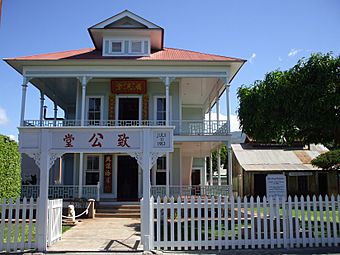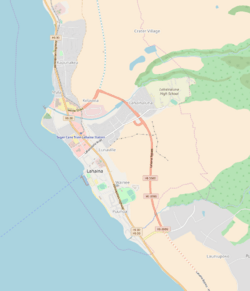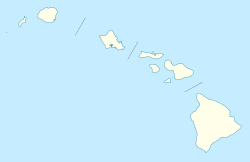Wo Hing Society Hall facts for kids
|
Wo Hing Society Building
|
|

Front facade and entrance, October 2007.
|
|
| Location | 848 Front St., Lahaina, Hawaii |
|---|---|
| Built | 1912 |
| Architect | Chee Kung Tong Fraternal Society |
| Architectural style | Chinese Feng Shui principles |
| MPS | Chinese Tong Houses of Maui Island TR |
| NRHP reference No. | 82000173 |
Quick facts for kids Significant dates |
|
| Added to NRHP | November 15, 1982 |
The Wo Hing Society Hall (Chinese: 和興會館; Jyutping: Wo4 Hing1 Wui6 Gun2) was a special building in Lahaina, Hawaii. It was located on Front Street in the historic district. Built around 1912, it was a meeting place for the Chinese people living in Lahaina. Many of these people worked in the sugarcane fields.
The Wo Hing Society Hall was a place for friends to gather and help each other. By the 1940s, fewer Chinese people lived in Lahaina, and the building was not used as much.
In 1983, the Lahaina Restoration Foundation helped bring the building back to life. After being fixed up, it opened as the Wo Hing Museum in 1984. It was one of only two Chinese society halls left on Maui. The building was recognized as an important historical site. It was added to the Hawaii State Register of Historic Places on July 30, 1982. It was also added to the National Register of Historic Places on November 15, 1982.
Sadly, in August 2023, the Wo Hing Society Hall was destroyed by the terrible 2023 Hawaii wildfires.
Contents
History of the Wo Hing Society
In the mid-1800s, many Chinese workers came to Hawaii. They came to work on the large sugarcane plantations. Most of these workers were single men. After their work contracts ended, some decided to stay in Hawaii. They started new jobs and businesses.
Because they were far from their homes in China, Chinese societies were formed. These groups, sometimes called "Tongs," helped people. They offered friendship, support, and even helped with religious needs. They also provided help for families when someone passed away.
Around 1909, the Chinese community in Lahaina started their own group. They called it the Wo Hing Society. This society was connected to a larger group called the Chee Kung Tong. With money from donations, the Wo Hing Society Hall was built in 1912.
By the 1940s, many Chinese residents moved to Honolulu for new opportunities. This meant the Wo Hing Society Hall was used less and less. The building became old and damaged by termites and rot.
In 1983, the Lahaina Restoration Foundation stepped in. They made an agreement with the Wo Hing Society to fix up the building. The goal was to restore it and open it for everyone to visit. The restoration was finished in 1984. The building then opened as a museum, showing the history of Chinese people in Lahaina. It was considered one of the best-preserved Chinese society halls in Hawaii.
Exploring the Buildings
The Wo Hing Society Hall property had two main parts. There was a larger main building with two floors. There was also a separate cookhouse next to it.
The Main Building
The first floor of the main building was like a museum. It displayed many Chinese items and things from Lahaina's past. These items showed what life was like in the early 1900s. Many of the exhibits focused on the time after sugarcane farming became big on Maui.
The second floor held a special place: the only public Taoist temple on Maui. Here, you could find altars dedicated to important figures. These included Lord Guan and other Chinese Deities. There were also other Chinese artifacts displayed on this floor.
The Cookhouse
The cookhouse was a separate building. It was built apart from the main hall to prevent fire. This was a smart safety measure. Inside, the cookhouse showed many old cooking tools. Later, it became a small theater. A special highlight was showing old films of Hawaii. These films were taken by the famous inventor Thomas Edison in 1898 and 1906.
Meaning of "Wo Hing"
The name Wo Hing (Chinese: 和興; Jyutping: wo4 hing1) has a special meaning. It means "harmony and prosperity." Wo stands for peace and harmony, and Hing means prosperity or success. You could see this meaning written on special calligraphy boards inside the temple.
The building was also designed using Feng Shui principles. Feng Shui is an ancient Chinese practice. It's about arranging things to create good energy and balance. For example, the front of the Wo Hing building faced the ocean. Its back was towards the mountains. This was a common Feng Shui design choice.
Images for kids
-
Second Floor Altar to Lord Guan. Other guardian Deities altars are to the left and right of the photo. An altar to the deceased is to the right of the photo behind the chain barricade.
See also











